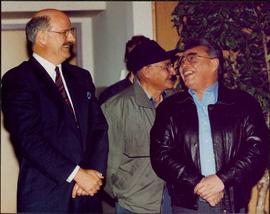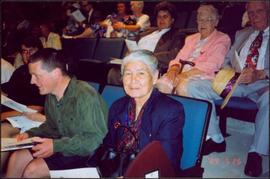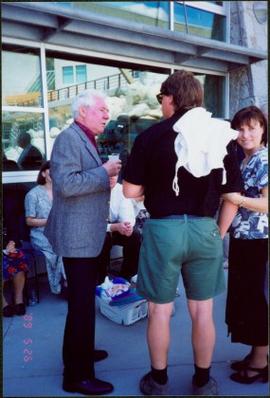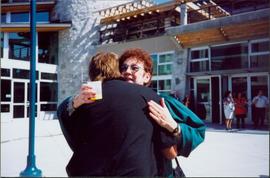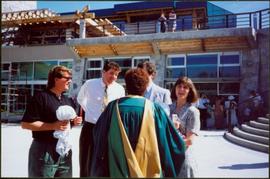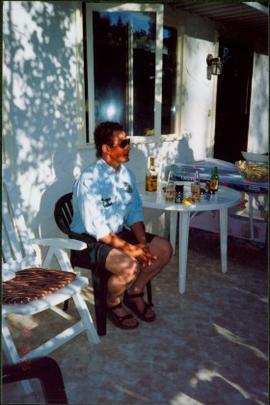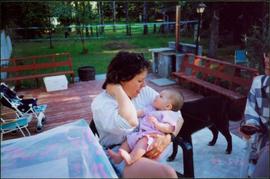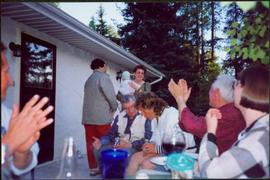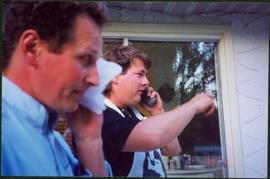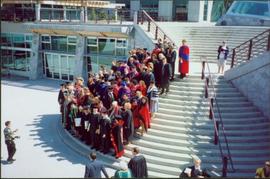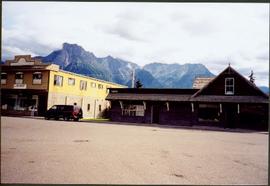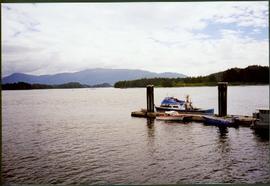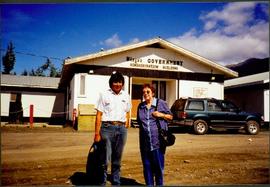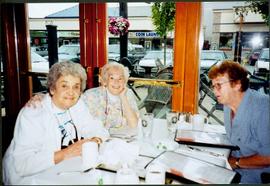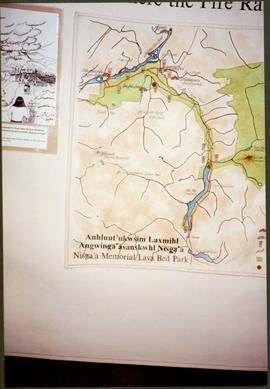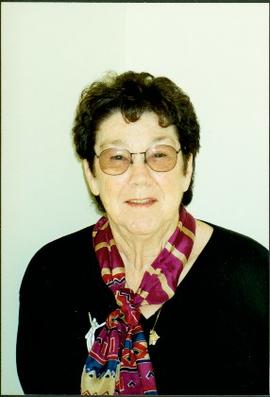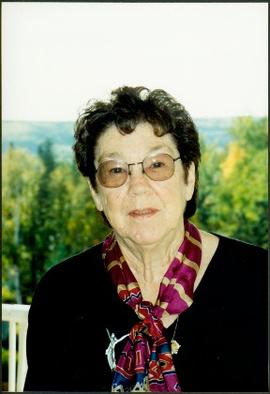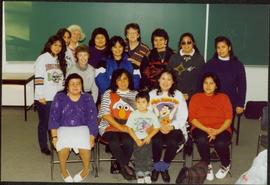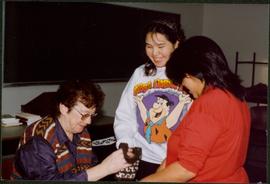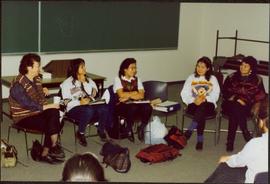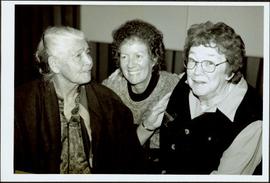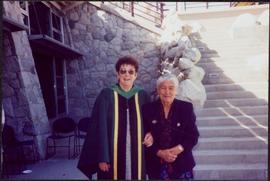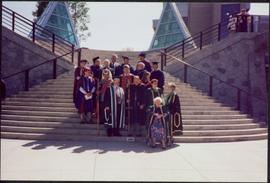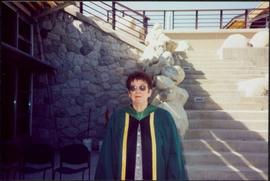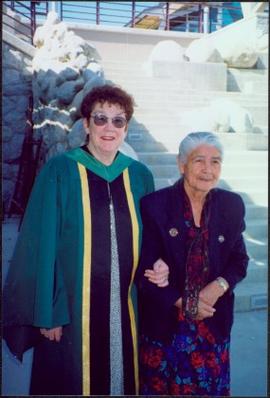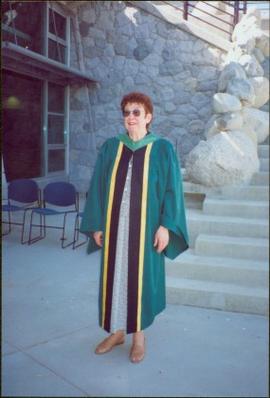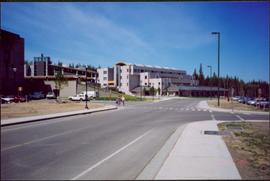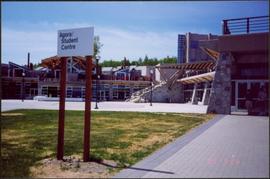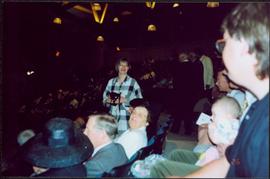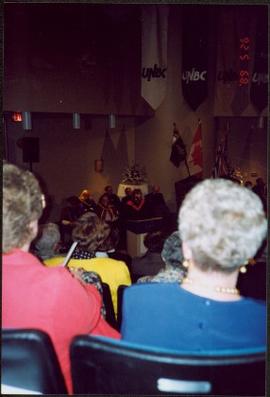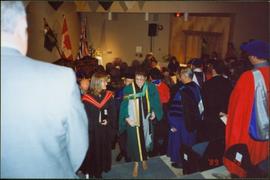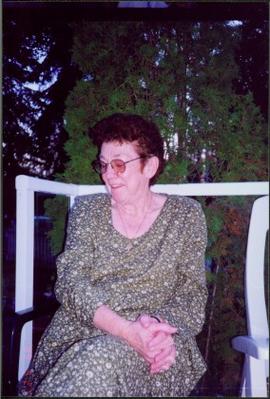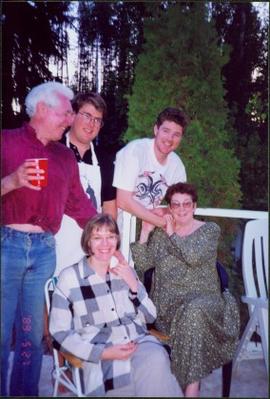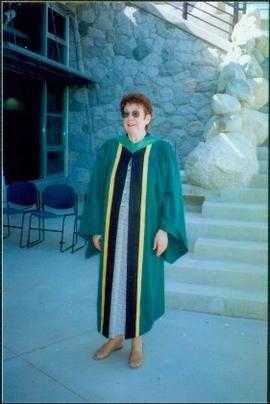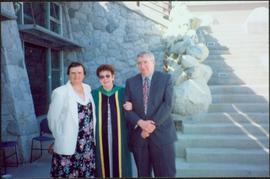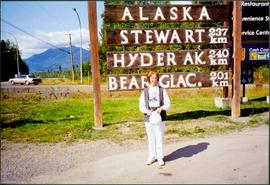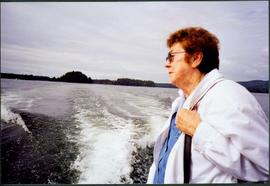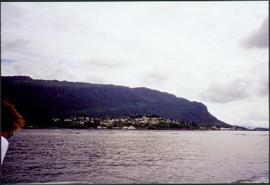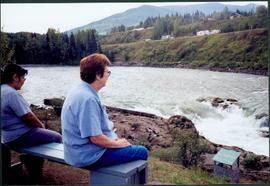Photograph depicts Justa Monk standing to right of Premier Harcourt in unknown room. John Alexis can be seen between them in background. Handwritten annotation on recto of photograph: "Justa Monk / John Alexis Tachie Village / The Premier / Taken in Prince George, B.C. Jan 23/95 / 'The day Kemano 2 was killed'."
File consists of:
- Everywomans Books 20th Birthday Party Celebration, 1975-1995 featuring an advertisement for a reading Bridget Moran
- "Together again..." by Martha Perkins, 2 pages (Haliburton County Echo, June 13, 1995)
- "History: Manslaughter, then Justa for All" (B.C. Bookworld, Spring 1995).
File consists of one 5.25" floppy disk, containing the following files:
- “AM 1”- On Writing Well by William Zinsser
- “AM 2”- Steps on rewriting
- “AM 3”- Articles and Columns
- “AM 4”- Getting Published
- “Blocks”- Anybody Can Write – writer’s block
- “Plot”- Writing examples
- “PM 1”- Ten Commandments for a Writer
- “PM 2”- The Short Story
- “PM 3”- Discussion
- “PM 4”- Reading
- “Workshop”- Schedule for Workshop
Audio recording is an interview by Bridget Moran with Paul Ramsey. At the time of this interview (December 1995) Paul Ramsey was serving in the BC provincial government (NDP) as the Minister of Health and Minister Responsible for Seniors, a post he held from September 1993 to February 1996. Bridget Moran interviews Paul Ramsey on the state of health care in Prince George. Moran notes in the interview that this material is for an article that she is writing on the crisis in health care in Canada.
Audiocassette Summary
- Paul Ramsey discusses why doctors have left Northern BC; specifically the case of orthopedic surgeons leaving Prince George
- Ramsey discusses burnout by physicians, more money in private sector
- Ramsey discusses the impact of a two tier health care system in Canada; the treatment of health care as a ‘consumer good’
- Ramsey compares the Canadian health care system with the U.S. health system
- Discusses specific case of doctors in Prince George – re. the direct billings crisis in 1993
- Ramsey describes changes in medical training; specialists versus general practitioners
- Budget – cost of health care $6.6 billion – 1/3 of provincial expenditures; expecting cuts in health care by spring 1996
- Expands on what he sees as the federal government’s view of universal health care in Canada; including views of individual politicians, both federally and provincially.
- Bridget provides her views on the pitfalls of a two-tier health care system based on personal experiences and family members’ health care history
- Ramsey provides his views on the British Columbia Medical Association
- Ramsey discusses cases of Prince George doctors who started direct billings to patients and settlement of cases
Photograph depicts Mary John sitting next to aisle in Canfor Theatre at the University of Northern British Columbia in Prince George, B.C. Unidentified individuals seated in foreground and background. Accompanying note from Maureen Faulkner: "Mary John takes my seat." Photo taken on the day Bridget received an Honourary Law Degree, before ceremony began.
Photograph depicts group of three standing in Agora courtyard at the University of Northern British Columbia in Prince George, B.C. Unidentified individuals sit in background. Accompanying note from Maureen Faulkner: "Mike, Tracy & Pat - we're having cookies & juice." Photo taken on the day Bridget Moran received an Honourary Law Degree.
Photograph depicts Moran wearing regalia, embraced by her son Mike in Agora courtyard at the University of Northern British Columbia in Prince George, B.C. Unidentified individuals stand near Winter Garden in background. Accompanying note from Maureen Faulkner: "Mike Congratulations Mom!." Photo taken on the day Moran received an Honourary Law Degree.
Photograph depicts Moran wearing regalia, facing away from camera in front of family members in the Agora courtyard at the University of Northern British Columbia in Prince George, B.C. Sons Mike (wearing black) and Pat stand on left, and Paul Ramsey stands in grey suit, semi-visible behind Moran. Unidentified individuals stand near Winter Garden in background. Photo taken on the day Moran received an Honourary Law Degree.
Photograph depicts Dave seated in lawn chair on deck in backyard. Chairs and tables set with food and beverages are also visible on deck. Accompanying note from Maureen Faulkner: "Dave looks on... He wished he'd been able to attend the ceremony. Next time?" Photo taken on the day Moran received an Honourary Law Degree from the University of Northern British Columbia in Prince George, B.C.
Photograph depicts Maureen Faulkner holding baby named Caitlin on deck in backyard. Bridget Moran's daughter Roseanne sits on far right, beside black dog. Forest and fence visible in background. Accompanying note from Faulkner: "Me, batting bugs & chatting to Caitlin. A lovely wee girl." Photo taken on the day Moran received an Honourary Law Degree from the University of Northern British Columbia in Prince George, B.C.
Photograph depicts Moran holding infant, approaching applauding group seated on deck in backyard. Table with beverages stands in foreground. Trees in background. Accompanying note from Maureen Faulkner: "You arrive on the deck too." Photo taken on the day Moran received an Honourary Law Degree from the University of Northern British Columbia in Prince George, B.C.
Photograph depicts Bridget Moran's son Mike speaking on telephone in backyard, man named Mike in foreground. House in background. Accompanying note from Maureen Faulkner: "Mayo on the phone to Mike. Dave looks like he's got an onion in his eye." Photo taken on the day Bridget Moran received an Honourary Law Degree from the University of Northern British Columbia in Prince George, B.C.
Photograph depicts large group posed on ceremonial steps in Agora courtyard at the University of Northern British Columbia in Prince George, B.C. Most individuals in group wear regalia. Bridget Moran stands in the second row, fifth from right (wearing sunglasses). Other individuals can be seen standing around group. Photo taken on the day Moran received an Honourary Law Degree.
Photograph depicts two large buildings across street in foreground, van visible on left.
Photograph depicts small boats tied at dock on lake with mountains visible in background.
Photograph depicts Bridget Moran standing beside unidentified man in front of white building with the sign "Nisga'a Government Administration building". Suburban parked in front of building, trees and mountains visible in background.
Photograph depicts Bridget Moran seated on far right, two unidentified woman on left. Vehicles and shops on street visible through windows in background.
Photograph depicts colour map displayed in unknown area, second poster semi-visible on left. See item 2008.3.1.22.34 for image believed to depict lava bed.
Photograph depicts close view of Moran wearing black shirt and colourful scarf, white wall in background.
Photograph depicts close view of Moran wearing black shirt and colourful scarf, forest visible in background.
File consists of:
- "Past mistakes recorded in new book" (Vancouver Sun, May 8, 1995)
- "Murder led to election as tribal leader: social worker recorded story" (Vancouver Courier, Dec. 28, 1984)
- Transcript of "Harkins! Bob Harkins Comment" re: Justa publication (Monarch Broadcasting, Nov. 21, 1994)
- "Fascinating life, times of Justa Monk" (The Prince George Citizen, Feb. 2, 1995)
- "Justa: A Review" (Central Interior NDP News)
- "Blanket coverage" (B.C. Bookworld, spring 1995)
- "Manslaughter, then Justa for all" and "Blanket coverage" (B.C. Bookworld, spring 1995)
- Fax from Laura Boyd, Northwood Pulp & Timber to Justa Monk (and Bridget Moran?) re: names and positions of executive staff at Northwood (Nov. 14, 1994).
Photograph depicts a young boy and group of fourteen women posed for photograph in classroom, chalkboard in background. Handwritten annotation on recto of photograph: "Aboriginal Women's Training Program, Cowichan Campus, Malaspina University College, Duncan BC".
Photograph depicts Moran seated to left of two students presenting small knitted craft. Desk and chalkboard in background. Photograph was taken at session of Aboriginal Women's Training Program at the Cowichan Campus, Malaspina University College, in Duncan B.C. Handwritten annotation on recto of photograph: "Gifts from Charlene + Joanne Smith".
Photograph depicts Moran seated on far left, in circle of women in classroom. Desk and chalkboard in background. Photograph was taken at session of Aboriginal Women's Training Program at the Cowichan Campus, Malaspina University College, in Duncan B.C.
Close view of three women at unidentified location. Left to right: John, Hope, Moran.
Item is a audio interview recorded by Bridget Moran with Justa Monk.
Audiocassette Summary
00’ 10” Moran is asking Justa about how he is feeling because he had a major heart attack. He talks about recovering from his attack in a week.
02’ 15” Moran asks Justa about what he thinks about the Gustafson Lake situation. He says he predicted it because the government has not been serious enough in negotiations for land claims. He does not believe in militant reactions and wants peaceful negotiations.
04’ 54” Moran asks Justa about what helped him get out of the ‘trench’ he was in after murdering his brother. He was able to carry on partly because he was forgiven by his family and the elders. He says the elders were the people who convinced him to plan for his future. He took their advice seriously, hence why he took on leadership roles.
07’ 15” Justa talks about taking a group of students to meet Gino (?), a hockey player. He says he wants to make things better for the young people because of alcohol and drugs, so believed the trip helped the students he took on the trip.
13’ 34” End of tape.
File consists of a videocassette (VHS) recording of Justa Monk giving a talk to a UNBC Carrier Culture Course (First Nations Studies 163) on October 24, 1995.
Videocassette Summary
Context: Justa Monk speaks to students in the UNBC Carrier Culture Course (First Nations Studies 163)
Introduction: Justa Monk is seated at a table situated at the front of a lecture theatre (?) speaking in a lecture style that ended in a question-answer format with several students in the FNS 163 class. The videotaping does not commence from the beginning of the lecture as there is no introduction to Justa Monk by the instructor and there is no immediate indication as to who the instructor is.
Justa wrote his book because his elders requested him to, and his people requested him to share what he went through and what alcohol had done to him. So he thought about it. Throughout his leadership, many people talked with him about their alcohol problem and how they couldn’t get out of the trench they were in. He wrote the book to tell them that ‘yes’, they can get out of the trench and that ‘yes’, they can change. Other reasons why he wrote his book: when his people get into trouble, they often classify themselves as a ‘nobody’ – when they read his book, they see the trouble he went through: first, at young age, when he started drinking after he left residential school. Then as he grew, it got to point where he couldn’t control his drinking- where he was blacking out and didn’t remember why he was in jail. When he got drunk he was a fighter, even though he was small. He didn’t care. He would work everyday and fight every weekend. Growing up on reservation, there is no choice as to future and not much to do so many turn to booze. Every time a friend or relative had alcohol they would share it with their next closest friend or relative. In his family, his brother came over to the house to invite him to drink over-proof rum with him. He blacked out, killed his brother and spent time in jail. He was very suicidal. He didn’t want to live after what he did. His lawyer talked to him. Upon his release he thought he lost the respect and love of his family and his community. It surprised him that he was forgiven and that he had a future in his life. It was hard. It still bothers him after 29 years.
When he came back to his community the elders came to talk to him about his leadership qualities. He didn’t know what they were talking about. The elders told him that in past he made mistakes, but that he can iron out his mistakes and show his leadership and that’s what happened. He became band manager, then band manager and chief,and then chief and so forth. That is why he wrote that book.
‘Yes’, he listened to his elders, ‘yes’, he was a drunk, ‘yes' he made a mistake because of alcohol. He came out of his trench and became a leader. There is hope to change if there is a wish to change.
He also wrote his book because no one in his territory, except Mary John, had been able to share with non-Indians the way of life they lived - off the land. He grew up on an isolated reserve, and lived off the land. He didn’t understand English until he went to [Lejac] residential school. It’s really hard to make people understand today, what First Nations people were like in his day. In his family there were 11 of them. His father made something like 50 cents a day to support them all - it was really hard.
When Justa went to residential school, he didn’t know how to speak or understand English. His parents didn’t go to school at all. His Dad knew some English because he worked off reserve at a lodge. On his first day of residential school, he asked his brother why they were taking away his clothes. A priest smacked him and told him ‘he was not to use that language around here’. Residential school has done some harm, a lot of harm, to his people. On the other hand, he cannot totally criticize these schools as they disciplined some people – many people in leadership positions today grew up in residential school. Residential schools were told by the government to make assimilate the children and make a white person out of a brown person. He thinks they went about it the wrong way. That is where the frustrations of First Nations people come. You see and hear about abuse. His people are suffering from the consequences of the stupidity in the way they tried to make his people assimilate. Because of that, there is abuse going on amongst his people. Aside from that, he one of lucky ones to go home and retain language and culture: now he can live in 2 worlds – the world of the white man and the Indian world.
Culture-wise they were taught to respect. Mom was boss in house. If they didn’t do what mom said, dad would punish them but his parents wouldn’t lay a hand on the children. They taught children how to respect the land, and other people. They taught him how to use the land. Sophie Thomas, elder who does Indian medicine in Stoney Creek lives the belief that every time you take something from land you replace it with something. When Sophie takes things for Indian medicine she replaces it with tobacco.
He wonders if his people will ever have the opportunity again to hunt and fish anywhere they want. He doesn’t think so. When people started warring about the land there was a lot of bloodshed in the early 1900s before the Europeans came. His people worried that there were too many dead amongst the Indian people, and they had to do something about it. In 1921 they came up with the idea of potlatch as they needed peace amongst the people as there was too much bloodshed. To him ‘potlach’ means respect, love and sharing. If you’ve done something to wrong your neighbour instead of fighting, clans would call a potlatch right then and invite all. They would put the fighters in the centre and each were told no more fighting. This still goes on. There is also a potlatch for death of people. There are four clans in a potlatch: caribou, beaver, frog and bear (?)
A long time ago First Nations people fought for land but they had respect for land; that is why they had to protect the land and kill one another for it. If someone trespassed without permission, they could die. People talk about self-government today. The young generation of his people didn’t even know there was self-government amongst their own people, that they controlled their own people. They had no government programs, they were living off the land and controlling their own people. They used to have Watchmen, who looked after the community. The 1 and only person they had to answer to was the hereditary person, who overlooked the territory, their lands. So when someone did something they weren’t supposed to do, that person went in front of the hereditary person to receive a punishment. He was taught that boys weren’t even allowed to kiss a girl, without proving to her family that they were a good hunter and provider. If they did, they would be held up to all and embarrassed. They might be beaten if they still didn’t understand their punishment. They may also have been banished. No one would protect this person, not even their immediate family as everyone knew that the person did wrong and was receiving the correct punishment. His people had their own controls and justice system. Self-government - if you lived in late 1800s / early 1900s – was very different from how it is referred to nowadays. He wonders if leadership and his people really know what they are talking about when talking about self- government.
Land claims and the treaty process – he was told by his elders not to say land “claims” but rather the land “question”. Many people are scared about the land question. Different political parties say different things and people are getting really confused. The whole land question is referring to the fishing, hunting, burial, berry picking, fishing habitats: the grounds where his people used to make their living off the land – this is what the elders are talking about and want to protect. The clans are talking about traditional territories. Many people lived off the land until 1970, therefore their people are still living off the land. There are many traditional territories still out there.
He considers himself an inmate of Canada – a jail bird. When the Hudson’s Bay Co. first started, the government started to make reservations. They gave so many acres to First Nations people as ‘reserves’ and they put a number to each reserve. As they put people onto the reserves, they also ‘branded’ them with band numbers and put ‘guards’ over them – aka the “DIA”. His people had no input. They were given programs and free education etc and were now labeled by non-natives as bums who pay no tax and receive free programs – but they had no input.
You look at the Indian Act you can see that land doesn’t belong to his people. Even the reserve isn’t theirs. They don’t own anything, yet they are known as the First Nations, the First Peoples. They live in that little jailhouse. They receive their free programs and some are very beneficial to his people, but he wishes they had a say. Land claims are not dangerous. Justice must be cleared up. Once this is done there will be a big opportunity for their future children to have a better life. They must get this uncertainty out of the way. That’s what he’s trying to do. He believes they need a chance to have their say regarding things that are happening around them. To be able respect the culture they are from, and to recognize who they are they must clear the air. There is a lot of frustration out there, especially within the younger generation. He has been taught to have patience and respect. In the early ‘30s in Fort St. James, the dirty ‘30s, his dad taught him to share what provisions they had. People still thank Justa for that kindness of his parents. He believes starvation is coming due to dwindling resources and too many people. He says everyone must set aside their differences re: the land question and see what can be done to change it for the betterment of the children. If the government would deal with the land question openly and in fairness, it would be resolved. But they want to lie about things. You need to treat everyone fair. That is the way he sees the treaty process. He wants to get rid of the Indian Act and draft something that will be fair to everybody.
Kemano II (KII) is something no one follows up on anymore. In 1989 when he was general band manager, he went to court in Vancouver with many elders. The court threw them out. He fought KII so hard because he knew that when you kill the river (the Nechako), you kill all that is in it. When a river dies there is no more salmon. If the Nechako died, the Stewart River would die and then Stewart Lake would die too. And if the Nechako was gone the Fraser Rriver would be drained down. KII just looked at reversing the Nechako but it didn’t look at the affect it would have on other waterways. That’s why he fought so hard. Justa’s mandates a chief: 1) to get land claims on the table again; 2) to kill KII; 3) to get rid of the DIA office in PG; 4) to get education for their people. He fought KII not because they didn’t like Alcan – it was their way of life that was going down. There is not only salmon in the Nechako – there are many species which were feeding his people. He fought KII legally through funds from his people -
$1.3million. He is proud they made the decision not to go along with the project. This topic he touches upon briefly in his book.
[Note: It is very difficult to hear many of the students’ questions. Most questions as they are identified below are summaries of what was believed to have been said]
Q: How can he belong to 2 clans?
Justa: He belonged to mother’s frog clan when he was growing up. Then one day the caribou clan asked him to go out and invite people to their potlatch. During this potlatch he was asked to sit in middle between clans. The spokesperson for caribou clan said they were going to “buy” Justa Monk. One of the caribou elders said Justa’s father is a caribou and so they want him as a caribou and take him away from his mother’s frog clan. His dad was very happy about this, but his mother was upset. The beaver clan then planned a potlatch and asked him to invite people to their potlatch, and again he was asked to sit in the middle as they wanted to buy the other half of him. So he is also part of the beaver clan. He was bought out of respect due to his leadership qualities. He used to help his elders a lot ever since he was young and that is why his leadership was recognized.
Q: Where are your kids, and what clan are they?
Justa: They are at home. The kids belong to his wife’s clan – Caribou. He adopted 2 children: a daughter and a son.
Q: You want to look ahead, what do you want to bring with you?
Justa: You can’t turn back the clock and live off the land again. Some people don’t even understand their own language. To live off land, and do potlatch all the time – you can’t do it. These cultural events are disappearing. He wants to make his culture and the white culture work together in order to make it work for his young people. With technology the way it keeps going, his people have to get more education.
There is no chance for them to go back. With clear cutting, his people can’t even trap anymore. So it is better to set it up, so that Canadian and Indian culture can work together.
Q: How do you see the land question getting settled?
Justa: In traditional territories, there are only some places we can hunt for bear and dear. They hang out between willow and poplar trees. When logging we have to leave something for animals. If they don’t have shelter they won’t last long. In traditional territories, we need to leave those places alone so the animals can survive. We must all have a say in how the land can be used properly – it needs to be a join venture.
Q: If land claims are settled, people in the DIA would lose their jobs. Maybe this is why they are dragging their feet?
Justa: If land claims were settled, yes, 40-50,000 people might lose their jobs. The government would save a lot of money.
Q: How would you model your people’s government?
Justa: Don’t want to repeat something already done. For their money, they would chose the best way for them.
Q: re: logging [inaudible]
Justa: They are not going to clear cut. Selective logging has worked in past. The government is going to run into trouble by clear cutting. At Nakalak Lodge, if you look at both sides of hill in summer, you wouldn’t know it’s been logged because it was selective logged. You can’t even see skid roads. If it (destructive logging practice) keeps going the way it is now, there is going to be winds that are going to be damaging to us.
Q: re: spiritual practice as it relates to logging
Justa: There are certain areas in their territory where spiritual things happen and so these areas wouldn’t ever be touched. His elders would look at the territory and identify which areas are to be protected. You must involve grass roots people in the selection process. We don’t have medicine men and women they way the used to – they no longer exist.
Q: re: difference between statistics released by the government and those produced by Justa in his book. Justa: Don’t listen to what the government has to say. His people are not dummies, they just have nothing to do and are sitting around on reservation.
Q: Do you pay other people to build housing on reserve?
Justa: We build our own houses and have our own electricians. Once the land question is settled he thinks a lot of joint ventures can be developed that will get his people off welfare.
Q: When your traditional areas are under the administration of his own people, would there be restricted access to these areas by non Indian people?
Justa: He didn’t think so. We would need to develop how to use the land and how to share it. But there would have to be some controls over the land somehow so it wasn’t abused.
Q: There must still be a lot of hunting and trapping even if a person can’t live off land anymore
Justa: Yes, many people are still hunting and trapping.
Q: How do you think social problems for your people can be fixed?
Justa: On reservations or in the city we need to start teaching our children way of life their elders grew up with. Right now they have TV, drugs and alcohol and that is distracting them. His people have to make time for the children. He regrets bringing TV to reserve when he was band manager.
Q: Are there any female band leaders?
Justa: Yes. Like the BC Indian Chief – Wendy Grant, he nominated her. A long time ago no there were no female band leasers as the women were at home with their children. Men were more up front about leadership.
Q: It seems that the native community can heal itself. Non-native communities spend a lot of time trying to heal native community but from his readings he thinks native communities can heal itself.
Justa: Settling the land base is required. When he was band manager, he made 5 emergency trips- suicide related- in one day; so he believes healing and pride will come back when the land base is settled.
Q: In the Artic, people control hunting and fishing via co-ops.
Justa: His people control their own hunting by season. No one is trigger happy. No one shoots just to shoot.
Justa: He is currently working with Northwood to educate First Nations peoples and teach them about Northwood sawmills etc. He is also finding out trapping takes place so Northwood doesn’t log there.
[Extensive question/answer period ensues whereby logging and wood processing techniques, ventures and technology on reserve and off are discussed.]
Justa: He is now taking a rest from leadership as he had done it for 25 years. Now he is starting to understand the people around him as he was being brainwashed by government after having to deal with them for so many years.
The instructor thanks Justa and gathers up her class to take them to the First Nations Centre.
Tape ends.
File consists of 2 VHS tapes: Tape 1 of 2008.3.1.201 is a video-recording of the UNBC May 1995 Convocation at UNBC held in the Canfor Room; however, Tape 2 of 2008.3.1.201 is a continuation of the TV broadcast from which Tape 1 was recorded. This broadcast continued on to feature footage of the “Oka Crisis”. This footage may comprise background material for future writing; or may simply have been the result of letting a VHS cassette tape continue recording.
Videocassette Summary
- Context: Video-recording of the UNBC May 1995 Convocation at UNBC held in the Canfor Room.
Highlights include:
- 00’03” Chancellor Iona Campognolo leads the signing of ‘O Canada’ with audience
- Follows with a prayer of incantation by the Reverend
- Welcome by President Geoffrey Weller. Weller outlines the brief history of UNBC and notes it is his final convocation as President and plans to return to teaching
- Chancellor Campognolo addresses the audience and thanks Weller for his time as President; the Chancellor congratulates the 10 graduates being honoured today
- 11’05” The Chancellor notes that 3 British Columbians are to receive honorary degrees today: Bertram ‘Victor’ McCabe of the Musk’wa People; Bridget Moran, writer of Stoney Creek Woman, historian Margaret Orsmby are to receive honorary degrees from UNBC
- 17’05” Dr. Robin Fisher, Acting Dean of Arts & Sciences introduces first honorary degree recipient historian Margaret Orsmby
- 23’28” Dr. Mary Helen Kelm, History Department introduces honorary degree recipient Bridget Moran Dr. Kelm discusses Bridget’s role as a social worker who brought about understanding of Carrier culture
- Best embodies ‘Community-centered’ approach
- Served in the Navy; Received her B.A. from University of Toronto in 1950
- Began career in social work in Prince George advocating for welfare recipients putting her career on the line
- Introduced to Bridget through the stories of Mary John and Justa Monk
- Kelm notes of Bridget “My relationship with the First Nations has made all the difference in my life” – Kelm notes of her “strong commitment to social change”
- 28’14” Bridget receives her degree; signs the guest book;
- Videotape recording continues with the remainder of the convocation ceremony
- 30’00” Dr. Jim McDonald, Chair of Anthropology introduces the third honorary degree recipient Elder Bert McKay, founder of the School District 92 First Nations Nisga’a, founding member of the Native Teachers Association.
- Followed by UNBC students receiving their degrees
- 35’36” President Geoffrey R. Weller introduces Bridget Moran to address the graduates
- 35’48” Bridget Moran gives a speech to the graduates of UNBC
- Bridget gives a talk – focusing on positive changes and negative change that requires still more movement
- She notes that positive change has occurred in the area of education for women whereas when she attempted to be accepted into graduate school at the University of Toronto in 1946, after her discharge from the navy in 1946, women were not encouraged into graduate studies in history
- Bridget notes that no financial support was offered to her from the Department of Veteran Affairs for studies towards a graduate degree in history; women were being encouraged to enter traditional field: teaching, nursing and social work. Bridget compares that with changes today wherein there is an abundance of women in history including she notes Dr. Mary Ellen Kelm and honorary degree recipient Margaret Ormsby
- Bridget notes that education was not forthcoming in the past for Native People; as Justa Monk noted to her; Monk noted that the federal government inflicted most harm in field of education for Native people
- Bridget discusses the struggle of Native peoples with education, including both struggles to acquire an elementary and high school education, let alone university – a Carrier graduate from a university did not occur until the late 1960s
- Bridget talks about the lack of a school in Stoney Creek as noted by Mary John and the residential school tragedy;
- Bridget talks about positive change with start of more Native People attending university
- Bridget addresses the graduates and recommends that they look to creating more positive changes - and not to fall for the old adage that one person can’t make change. Bridget refers to a talisman that she relied on from the past – and refers to a cartoon in the syndicated column from the 1940s - of two cats ‘Alex & Henrietta?’ and that the female cat’s incantation was ‘choose your day; choose your day, choose your day - what the heck; what the heck; what the heck – and ‘there’s a dance left in the old babe yet’
- 47:13 Bridget’s speech finishes
- Videotape continues with the remainder of the ceremony
- 28:52 Ceremony finishes with procession of graduates and faculty out of hall
- 63’00” Recording ends
Audio cassette contains recorded audio interviews with Bridget Moran and Barbara Whittington on a CBC Radio program regarding the Judge Gove inquiry.
Audiocassette Summary
Context: The recording is a segment from a CBC Radio program with broadcaster Mark [Forsythe?] interviewing Barbara Whittington, professor of Social Work at the University of Victoria [on the telephone] and former social worker Bridget Moran on the telephone from Prince George. They are being interviewed about the recent report released by Judge Gove into the case of the death of a Metis child ‘Matthew’ [Vaudreuil]. The interview focuses on the need for reassessment of social workers and contract workers training and social work education in British Columbia to be coordinated by educators and the Ministry.
Scope and Content: Recording starts with interview in progress – Barbara is answering question by Mark on the findings of the Gove inquiry- that the judge captured the “sadness” of Matthews’ death in the report.
Bridget is then asked by Mark her views on the Inquiry’s report. She states that she didn’t have any problems with what the judge said – but that there is nothing experimental being done here. She notes however that no specific mention is made of the fact that Matthew was a Metis child in a poor family – and that this should have been addressed in the report and findings. Bridget refers to the fact that somehow ‘social workers got the wrong message’ – and refers to her work experience as a social worker that if children were seen at risk in a home then there were removed from their home.
Mark questions Barbara on how the inquiry may impact the teaching of social work. Barbara states she doesn’t’ think it will affect the teaching; and that the report had positive comments on the social work program at UVic – and refers to the working of a ‘decentralized model’ of work. However she notes that a Bachelor in Social Work needs to be seen as a ‘entry point’ only – and that comprehensive training between the University and Ministry [of Social Work] is needed.
Discussion of social worker salary; burnout; and the issue of utilizing contract workers is discussed. Bridget notes that she did some research into this 2 or 3 years ago – and that of the 2000-3000 social workers in BC – there was another 10,000 contract workers doing work ‘that don’t know what they’re doing’ – uneducated workers – dealing with the assessment of potential children at risk.
Barbara agrees that many are not well trained and not well supported and that a coordinated effort with the Ministry is needed so that burnout is addressed and that social workers get the support needed.
Barbara concludes that the report should have addressed the issue of contract workers more than it did. She also notes that it should have addressed the need for First Nations community training in social work
– and notes that there are many First Nations community members ‘ready to go’ with this training. Bridget agrees that this issue was not adequately addressed – and notes that about 60% of children in foster homes are aboriginal. She notes that if we ‘fail a person in one generation’ [as was Matthew’s mother] then we ‘fail children in the next generation’. Barbara agrees.
Mark thanks them both –
End of interview
Audio cassette contains recorded audio interviews from a CBC Radio program interviewing Bridget Moran in the CBC Prince George studio on the recent publication of Justa.
Audiocassette Summary
Context: The recording is a segment from a CBC Radio program with broadcaster Mark [Forsythe?] interviewing Bridget Moran in the CBC Prince George studio on the recent publication of Justa. Mark first speaks to Justa by telephone asking him why he wanted his story told.
Scope and Content: Mark notes that Bridget Moran has just published a new book about the life of Justa Monk, entitled Justa: A First Nations Leader. Before speaking to Bridget, he speaks to Justa by telephone and asks him why he wanted his story told.
Justa says he wanted to tell people about the story of his life but also about the hardships of his people; for example he notes the transportation in the early years was difficult and that it took 21 hours by horse to travel from Tachie to Fort St. James. Also he says that what had happened to him [killing his brother] changed his life. He points out that in particular the Elders wanted him to tell his story. [Mark thanks Justa and the interview ends]
Mark then introduces Bridget Moran and asks her to comment on why she decided to write the book. Bridget first notes that she had heard about Justa’s life while writing the story of Mary John and that many people had suggested that she should write a book about his life as well. Although she had seen him at community events (potlatches) she was not introduced to him until November 1991. At that time he introduced himself and asked her to write his story – because he believed that it is possible to make amends for a bad life.
Bridget goes on to describe the circumstances leading to Justa killing his brother in a fight and that alcohol had been a factor. Justa had contemplated suicide.
Bridget then explains the setting of where Justa lived at Portage on Stuart Lake, 150 miles from Prince George. She notes that in many ways it was a very traditional life, totally dependent on the land. She says that Justa felt it was important in telling his story to tell native youth of ‘what they had – and what they had lost’.
Bridget then tells how Justa had been sent to a residential school at the age of 10 and that when he arriving the priest & nun took away his clothes. When he asks why – in Carrier – the only language he spoke – he was hit by the priest.
Bridget then talks about the structure of the book and notes that “what I was really doing was oral history.” She notes that she starting out interviewing him first because she notes she didn’t know him very well – but that it progress she then just talked with him. Bridget comments that Justa is a ‘real communicator’ and uses body language well – and she noted that he could remember details and emotions very well which gives a “sense of immediacy” to his story.
Mark asks Bridget to explain how Justa went from killing his brother – to becoming a leader of his people. Bridget notes that although it was felt he acted in self-defense, that Justa felt that he had to do penance for what he did. He was charged with manslaughter and served his time in a Forestry camp. After that he decided to go back to school and finish his education in Dawson Creek. He then decided to come back to Tachie to ‘make peace with his people’ and that the Elders forgave him and accepted him.
Justa then went on to work in the Band Office, then as Manager, then as Chief and in 1990 was elected as the Chief of the Carrier Sekani Tribal Council.
Bridget states that Justa’s legacy for native youth in particular – is that you can overcome hardships and turn your life around. Bridget notes that instead of drugs and alcohol that youths should look to their culture, language and Elders to help them.
Bridget then notes that her hope is to now hold workshops to help First Nations document their own history. To show them how they can take ‘raw material that I start work with’ and ‘work it up into a readable story.’ She hopes to hold workshops with Bands so that they can ‘do it for themselves’ – particularly as so many of the Elders are sick and dying and won’t be around to tell their stories.
Mark thanks Bridget –
End of interview
Photograph depicts Moran wearing regalia and linking arms with Mary John. Stone steps in background. The pair stands in the Agora courtyard at the University of Northern British Columbia in Prince George, B.C. Photo taken on the day Bridget Moran received an Honourary Law Degree.
Photograph depicts group of 17 men and women posed on ceremonial steps in Agora courtyard at the University of Northern British Columbia in Prince George, B.C. Most individuals in group wear regalia. Bridget Moran stands in first row, second from right.
Photograph depicts Moran standing in front of stone steps in Agora courtyard at the University of Northern British Columbia, in Prince George, B.C. Photo taken on the day Moran received an Honourary Law Degree.
Photograph depicts Moran wearing regalia and linking arms with Mary John. Stone steps in background.
Photograph depicts Moran standing in front of stone steps in Agora courtyard at the University of Northern British Columbia, in Prince George, B.C. Photo taken on the day Moran received an Honourary Law Degree.
File consists of:
- Letter of recommendation to Pat Sarsfield from Hon. Frank S. Perry, Q.C. re: Nomination of Bridget Moran for Honorary Degree from UNBC
- Letter of recommendation to Pat Sarsfield from Allan Bate, Q.C. re: Nomination of Bridget Moran for Honorary Degree from UNBC (Oct. 25, 1994)
- Letter of recommendation from Phyllis R. Parker, B.S.W. re: Nomination of Bridget Moran for Honorary Degree from UNBC (Oct. 24, 1994)
- Letter of recommendation to Maureen Horkoff from the Central Interior Regional Arts Council re: Nomination of Bridget Moran for Honorary Degree from UNBC (Oct. 11, 1994)
- Letter of recommendation from Anne Martin re: Nomination of Bridget Moran for Honorary Degree from UNBC (Oct. 29, 1994)
- Letter of recommendation to Pat Sarsfield from Susan Aoki, Director/Curator, Prince George Art Gallery re: Nomination of Bridget Moran for Honorary Degree from UNBC (Oct. 26, 1994)
- Letter of recommendation to Pat Sarsfield from Jenny Owston, Program Director, Elizabeth Fry Society re: Nomination of Bridget Moran for Honorary Degree from UNBC (Oct. 13, 1994)
- Letter of recommendation to Paul Thomson from Keith Gordon, Chair of the Local History Committee of the Prince George Public Library re: Nomination of Bridget Moran for Honorary Degree from UNBC (Oct. 24, 1994)
- Letter of recommendation to Pat Sarsfield from Bob Harkins re: Nomination of Bridget Moran for Honorary Degree from UNBC (Oct. 1, 1994)
- Letter of recommendation to Pat Sarsfield from Lois Boone, MLA, and Paul Ramsey, MLA re: Nomination of Bridget Moran for Honorary Degree from UNBC (Oct. 24, 1994)
- Hand-written note to Maureen Horkoff (?) from Debbie (?)
- Letter from the Nominating Group re: Nomination of Bridget Moran for Honorary Degree from UNBC (Nov. 17, 1994)
- Resume and Extracurricular Activities for Bridget Moran (5 pages)
- Congratulatory letter to Bridget Moran from Sandy Lockhart re: Nomination of Bridget Moran for Honorary Degree from UNBC (March 29, 1995)
- 43 Photographs taken, and notes given to Bridget by Maureen Faulkner, a long-time family friend and Prince George artist: View of Geoffrey R. Weller Library from University Way; caption: "walking up to Canada's newest 'U'-"; UNBC Agora; caption: "The processional gathers on the upper walkway"; UNBC Agora/Student Centre sign; caption: "The First Nations people, in button blankets gather"; Photograph of audience for Spring 2005 Convocation at UNBC (note attached: "The First Nations people, in button blankets, gather"); Bridget Moran's family members seated in the audience before the ceremony begins (Spring 2005 Convocation, UNBC); caption: "Next row down is R. & the Kennedy's, I move to join her next to walkway"; Roseanne Moran with a camera standing in the auditorium aisle before the ceremony begins (Spring 2005 Convocation, UNBC); Mary John seated in the audience before the ceremony begins (Spring 2005 Convocation, UNBC); caption: "Mary John takes my seat."; Unidentified Woman introducing Bridget Moran at UNBC's Spring 1995 Convocation; caption: "Young Dr. Mary Ellen Kelm as she introduces you. In front of me are 2 of my senior admin. Team - John Stevens & Jim Emrich (?) & their wives"; Bridget Moran accepting her honorary degree at UNBC's Spring 1995 Convocation; caption: "You are being summoned! You are very nervous here"; Bridget Moran accepting her honorary degree at UNBC's Spring 1995 Convocation; caption: "You are crowned queen 'Dr. Moran' Congratulations!"; Bridget Moran delivering the convocation address at UNBC's Spring 1995 Convocation; caption: "You are giving the convocation address. Nicely done! It's wonderful to know you and your family. I'm proud of you."; Bridget Moran's family at UNBC's Spring 1995 Convocation; caption: "Your family now behind R & me look on with pride and interest"; Bridget Moran walking up the stairs at UNBC's Spring 1995 Convocation; caption: "Up the stairs you march. This is a very emotional time for all of us!"; Bridget Moran walking up the stairs after the ceremony concludes; caption: "Pride and relief. R. is yelling "Mom, Mom, we're here!"; The 1995 graduating class at UNBC; caption: "Outside, the public photo session"; Photograph of the 1995 graduating class at UNBC taken on the ceremonial steps; Bridget Moran's daughter, Roseanne displaying the honorary degree at UNBC's Spring 1995 Convocation; caption: "R. proudly displays your fine honors!"; Mike, Tracy, and Pat having cookies and juice at UNBC's Spring 1995 Convocation; caption: "Mike, Tracy & Pat - we're having cookies and juice"; Bridget Moran speaking with unidentified man at UNBC's Spring 1995 Convocation; caption: "Who is this man?"; Bridget Moran and Paul Ramsey at UNBC's Spring 1995 Convocation; caption: "Your friend"; Bridget Moran hugging Mike at UNBC's Spring 1995 Convocation; caption: "Mike congratulations Mom!"; Bridget Moran hugging Pat at UNBC's Spring 1995 Convocation; caption: "Pat gets in on the action!"; Side view of Bridget Moran with her family at UNBC's Spring 1995 Convocation; Back view of Bridget Moran with her family at UNBC's Spring 1995 Convocation; Photograph of Dave (?) at the BBQ (1995); caption: "Dave looks on...he wished he'd been able to attend the ceremony. Next time?"; Maureen Faulkner holding Caitlin (1995); caption: "Me batting bugs and chatting to Caitlin. A lovely wee girl"; Celebratory barbecue for Bridget Moran (1995); caption: "Ah ha! BBQ at M & T's"; Celebratory barbecue for Bridget Moran (1995): Pat and Tracy?; Celebratory barbecue for Bridget Moran (1995): Maureen Faulkner (l) speaking with unidentified woman; Celebratory barbecue for Bridget Moran (1995): Bridget arrives at BBQ holding baby Caitlin, guests applaud; caption: "You arrive on the deck to..."; Celebratory barbecue for Bridget Moran (1995): Bridget Moran; Celebratory barbecue for Bridget Moran (1995); Celebratory barbecue for Bridget Moran (1995): Bridget Moran and children Pat, Mike and Roseanne and unidentified man; T.V. camera and crew speaking with Bridget Moran at the celebratory BBQ (1995); caption: "T.V. camera & crew document you, your life and family"; Bridget Moran hugging Mike Moran at celebratory BBQ (1995); Mike Moran and Dave (1995); caption: "Mayo on the phone to Mike. Dave looks like he's got an onion in his eye."; Roseanne Moran seated in patio chair at celebratory BBQ (1995); caption: "Roseanne - elegant"; Bridget Moran in full university regalia standing with Mary John at UNBC's Spring 2005 Convocation; Roseanne and Bridget Moran at UNBC's Spring 2005 Convocation; UNBC's 1995 graduating class standing on the ceremonial steps; UNBC's 1995 graduating class standing on the ceremonial steps; Bridget Moran in full university regalia at UNBC's Spring 2005 Convocation; Bridget Moran with Judy and Don Kennedy at UNBC's Spring 1995 Convocation
- Invitation from UNBC's Chancellor to attend the Convocation luncheon at UNBC (1995).
Photograph depicts road at University of Northern British Columbia. Library building stands in center background. Administration and cafeteria buildings can be seen in left background. Accompanying note from Maureen Faulkner: "Walking up to Canada's newest 'U' - ". Photo believed to have been taken on the day Bridget Moran received an Honourary Law Degree.
Photograph depicts the Agora center at the University of Northern British Columbia in Prince George, B.C. Sign in foreground reads "Agora/Student Centre". Unidentified individuals can be seen in red blankets on upper walkway in background, above the Winter Garden. Accompanying note from Maureen Faulkner: "The first nations people, in button blankets, gather". Photo believed to have been taken on the day Bridget Moran received an Honourary Law Degree.
Photograph depicts Roseanne standing in auditorium aisle in the crowded Canfor Theatre at the University of Northern British Columbia in Prince George, B.C. Family and friends of Bridget Moran believed to be seated in foreground. Photo taken on the day Bridget received an Honourary Law Degree, before ceremony began.
Photograph depicts woman at podium, individuals in regalia seated behind her against background wall. Audience sits in foreground in the Canfor Theatre at the University of Northern British Columbia in Prince George, B.C. Accompanying note from Maureen Faulkner: "Young Dr ___ as she introduces you. In front of me are 2 of my senior admin team - John Stevens & Jim [Emrich?] & their wives." Photo taken on the day Bridget Moran received an Honourary Law Degree.
Photograph depicts Moran holding framed certificate while walking up stairs in crowded Canfor Theatre at the University of Northern British Columbia in Prince George, B.C. Moran walks with unidentified woman, both wearing regalia. Accompanying note from Maureen Faulkner: "Up the Stairs you march. This is a very emotional time for all of us!." Photo taken on the day Moran received an Honourary Law Degree.
Photograph depicts Moran sitting in lawn chair on deck in backyard. Deck railing in midground, trees in background. Photo taken on the day Moran received an Honourary Law Degree from the University of Northern British Columbia in Prince George, B.C.
Photograph depicts Moran sitting in lawn chair on deck in backyard. Sons Mike (in apron) and Pat stand behind her, daughter Roseanne sits on left, unidentified man stands on far left. Deck railing in midground, trees in background. Photo taken on the day Bridget Moran received an Honourary Law Degree from the University of Northern British Columbia in Prince George, B.C.
Photograph depicts Moran standing in front of stone steps in Agora courtyard at the University of Northern British Columbia, in Prince George, B.C. Photo taken on the day Moran received an Honourary Law Degree.
Photograph depicts Moran standing in full university regalia between Judy and Don Kennedy in the Agora courtyard at the University of Northern British Columbia in Prince George, B.C. Photo taken on the day Moran received an Honourary Law Degree.
File consists of:
- 1 colour photograph of an elderly couple [Grace Boice, aka "Tommy" and Rex Boice] sitting hand in hand and side by side in lawn chairs on a patio. (April 1993)
- Newspaper clipping: "Together Again" (Haliburton County Echo, June 13, 1995)
- Victoria College Song " On the Old Ontario Strand"
- Program for Victoria College, 45th Reunion for the class of '50 (June 3, 1995)
- Events program for University of Toronto 1995 Spring Reunion*Song book for Victoria College, Class Reunion
- Letters from Grace Boice to Mickey [aka Bridget]
- Letter and 2 black and white photographs from Betty Pincombe, aka "Chick" to Mickey [aka Bridget] (Nov. 8, 1994); photos include: Three women in their Women's Royal Canadian Naval Service uniform standing on a beach (L-R: Bridget, Betty and Grace), ca. 1945; Three women in their Women's Royal Canadian Naval Service uniform sitting on a sandy beach (L-R: Betty, Bridget and Grace), ca. 1945.
Woman stands in front of sign that reads "ALASKA / STEWART 237 km / HYDER AK. 240 km / BEAR GLAC. 201 km". Second sign in background indicates restaurant, convenience store, and service centre. Car, road, and highway can be seen in midground; mountains in background. (This woman is also featured in item 2008.3.1.22.13).
Profile of Moran, wake visible in water behind her. Opposite shore in background.
Photograph depicts unknown lake. Moran slightly visible in far left. Village can be seen on opposite shore in background.
Photograph depicts Moran seated to right of woman on bench in foreground. Waterfall area at Moricetown Canyon can be seen below, behind booth labeled "MONITER BOOTH". Highway and houses visible on opposite shore in background.
